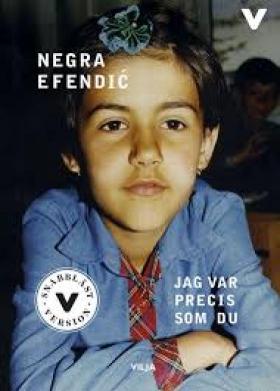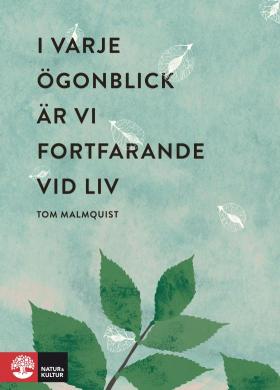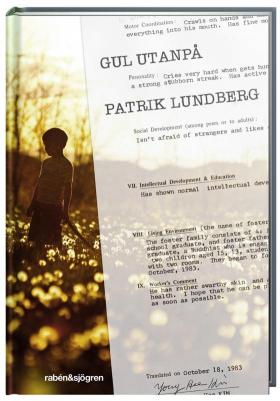
En storm kom från paradiset(A Storm Blew in from Paradise)
by Johannes Anyuru, reviewed by Nichola Smalley
Norstedts, 2012, 248 pages.
'En storm… is the best Swedish novel I have read in a long time. I would advise anyone interested in the writing process, in familial and national ties, in pain, healing, loss and rediscovery to read it.'

Hon minns inte(She Doesn’t Remember)
by Jonas Brun, reviewed by Andy Turner
Albert Bonniers förlag, 2021, 344 pages.
'Hugely timely but unusual from its male perspective, I am convinced Hon minns inte has a place beyond the Swedish language market alone... by the time we reach the end of these courageous pages, which is where the story begins, we feel we have been more than witnesses to an honest and impassioned exploration of experiences and emotions. We are profoundly moved and we are the better for it.'

Jag var precis som du (I Was Just Like You)
by Negra Efendić, reviewed by Tuva Tod
Natur & Kultur, 2016.
'Efendić’s Swedish is magnificent. She chooses to present her experiences in the present tense, which makes them more immediate... Her imagery is a particularly effective aspect of her writing... In this war- torn world, she shows our capacity for language as a means to cope.'

Tullias värld (Tullia’s World)
by Kerstin Ekman, reviewed by Sarah Death
Albert Bonniers förlag, 2020, 190 pages.
'In Tullia’s World, although acutely aware that we only know of these women through male voices, Ekman sets out with grace, inventiveness and often anger to shed light on hidden lives... For me, this relatively short volume feels full of distilled wisdom and experience. It is subtly autobiographical to its core and has many echoes of Ekman’s earlier works.'

Borde hålla käft – en bok om Märta Tikkanen (Ought to shut up – a book about Märta Tikkanen)
by Johanna Holmström, reviewed by Kate Lambert
Förlaget (Finland), Norstedts (Sweden), 2020, 432 pages.
'The biographical approach is personal. Holmström describes her visits to interview Tikkanen in the first person and in the present tense, initially sharing her trepidation at the first meeting and seeing her subject coming down the street with her shopping... I was expecting objectivity but the first-person narrative of the biographer herself makes this an accessible and engaging read.'

Dolda gudar: en bok om allt som inte går förlorat i en översättning (Hidden Gods: About Everything That Doesn’t Get Lost in a Translation)
by Nils Håkanson, reviewed by Fiona Graham
Nirstedt/litteratur, 2021, 357 pages.
'Dolda gudar is much more than a study of literary translation: it is also, in part, a social, cultural and literary history of Sweden.'

Mannen i skogen (The Man in the Woods: a Biography of Wilhelm Moberg)
by Jens Liljestrand, reviewed by Kate Lambert
Albert Bonniers Förlag, 2018, 731 pages.
'The biography does not assume knowledge, but neither does it talk down to the reader. Its wealth of detail, evidently thorough research, and 11-page index of people mentioned, also make it a valuable resource for students of Swedish 20th-century literary history and indeed Swedish 20th-century history in general.'

I varje ögonblick är vi fortfarande vid liv (At Every Moment We Are Still Alive)
by Tom Malmquist, reviewed by Janny Middelbeek-Oortgiesen
Natur & Kultur, 2015, 317 pages.
'I varje ögonblick är vi fortfarande vid liv is a novel based on real-life experiences that doesn’t pull any punches. It left me breathless. As far as I am concerned, Malmquist has written Love Story 2.0.'

Gul utanpå (Yellow on the Outside)
by Patrik Lundberg, reviewed by Lo Nathamundi
Rabén & Sjögren, 2016 (original copyright: Patrik Lundberg, 2013), 253 pages.
'The book is riveting. The uniqueness of the details and the descriptions, and the frankness and honesty of the storytelling lend it so much vivid character.'

Förintelsens Barn (Children of the Holocaust)
by Margit Silberstein, reviewed by Karin Filipsson
Albert Bonniers Förlag, 2021, 191 pages.
'Förintelsens Barn is a story about surviving the unthinkable and how to carry on this legacy of hope tainted by wild despair; being the child of survivors. Silberstein’s finely crafted narrative conveys her parents’ wondrous love story, which shines through the pages even in the depictions of horrific despair and paralyzing fear. '

Huset med de två tornen (The House with the Two Towers)
by Maciej Zaremba, reviewed by Fiona Graham
Weyler förlag, 2018. 303 pages.
'Maciej Zaremba’s incredibly rich book is many things: a personal memoir, an attempt to come to terms with his parents’ heritage, an exploration of the darkest chapters in Poland’s 20th-century history, and a monument to the victims of anti-Semitism and totalitarian oppression in its Nazi and Soviet bloc iterations.'

1947 (1947: When Now Begins)
by Elisabeth Åsbrink, reviewed by Anna Paterson
Natur & Kultur, 2016, 296 pages.
'Åsbrink casts her net wide to include something of everything, from entertainment to legislation to insurgency.... a wonderfully readable, insightful and often moving study of the past.'

